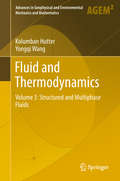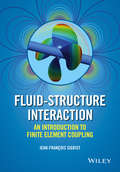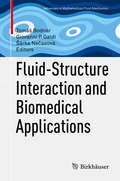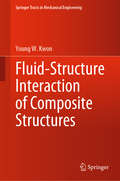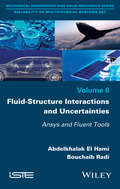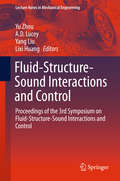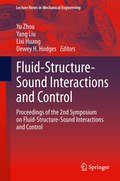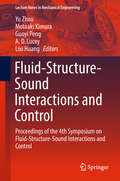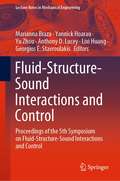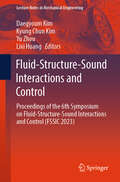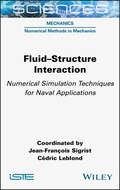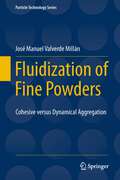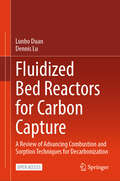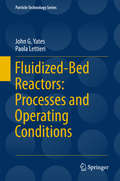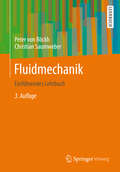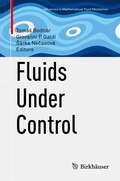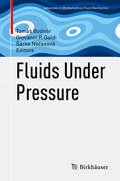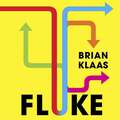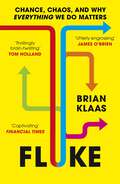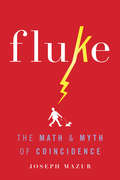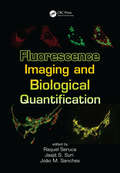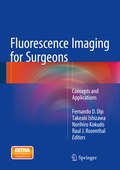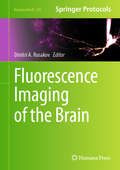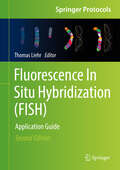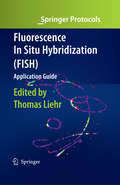- Table View
- List View
Fluid and Thermodynamics: Volume 2: Advanced Fluid Mechanics And Thermodynamic Fundamentals (Advances In Geophysical And Environmental Mechanics And Mathematics Ser.)
by Kolumban Hutter Yongqi WangThis third volume describes continuous bodies treated as classical (Boltzmann) and spin (Cosserat) continua or fluid mixtures of such bodies. It discusses systems such as Boltzmann continua (with trivial angular momentum) and Cosserat continua (with nontrivial spin balance) and formulates the balance law and deformation measures for these including multiphase complexities. Thermodynamics is treated in the spirit of Müller–Liu: it is applied to Boltzmann-type fluids in three dimensions that interact with neighboring fluids on two-dimensional contact surfaces and/or one-dimensional contact lines. For all these situations it formulates the balance laws for mass, momenta, energy, and entropy. Further, it introduces constitutive modeling for 3-, 2-, 3-d body parts for general processes and materially objective variable sets and their reduction to equilibrium and non-equilibrium forms. Typical (reduced) fluid spin continua are liquid crystals. Prominent nematic examples of these include the Ericksen–Leslie–Parodi (ELP) formulation, in which material particles are equipped with material unit vectors (directors). Nematic liquid crystals with tensorial order parameters of rank 1 to n model substructure behavior better, and for both classes of these, the book analyzes the thermodynamic conditions of consistency. Granular solid–fluid mixtures are generally modeled by complementing the Boltzmann laws with a balance of fluctuation (kinetic) energy of the particles. The book closes by presenting a full Reynolds averaging procedure that accounts for higher correlation terms e.g. a k-epsilon formulation in classical turbulence. However, because the volume fraction is an additional variable, the theory also incorporates ‘k-epsilon equations’ for the volume fraction.
Fluid-Structure Interaction
by Jean-Francois SigristFluid-Structure Interaction: An Introduction to Finite Element Coupling fulfils the need for an introductive approach to the general concepts of Finite and Boundary Element Methods for FSI, from the mathematical formulation to the physical interpretation of numerical simulations. Based on the author's experience in developing numerical codes for industrial applications in shipbuilding and in teaching FSI to both practicing engineers and within academia, it provides a comprehensive and self-contained guide that is geared toward both students and practitioners of mechanical engineering. Composed of six chapters, Fluid-Structure Interaction: An Introduction to Finite Element Coupling progresses logically from formulations and applications involving structure and fluid dynamics, fluid and structure interactions and opens to reduced order-modelling for vibro-acoustic coupling. The author describes simple yet fundamental illustrative examples in detail, using analytical and/or semi-analytical formulation & designed both to illustrate each numerical method and also to highlight a physical aspect of FSI. All proposed examples are simple enough to be computed by the reader using standard computational tools such as MATLAB, making the book a unique tool for self-learning and understanding the basics of the techniques for FSI, or can serve as verification and validation test cases of industrial FEM/BEM codes rendering the book valuable for code verification and validation purposes.
Fluid-Structure Interaction and Biomedical Applications
by Giovanni P. Galdi Tomáš Bodnár Šárka NečasováThis book presents, in a methodical way, updated and comprehensive descriptions and analyses of some of the most relevant problems in the context of fluid-structure interaction (FSI). Generally speaking, FSI is among the most popular and intriguing problems in applied sciences and includes industrial as well as biological applications. Various fundamental aspects of FSI are addressed from different perspectives, with a focus on biomedical applications. More specifically, the book presents a mathematical analysis of basic questions like the well-posedness of the relevant initial and boundary value problems, as well as the modeling and the numerical simulation of a number of fundamental phenomena related to human biology. These latter research topics include blood flow in arteries and veins, blood coagulation and speech modeling. We believe that the variety of the topics discussed, along with the different approaches used to address and solve the corresponding problems, will help readers to develop a more holistic view of the latest findings on the subject, and of the relevant open questions. For the same reason we expect the book to become a trusted companion for researchers from diverse disciplines, such as mathematics, physics, mathematical biology, bioengineering and medicine.
Fluid-Structure Interaction of Composite Structures (Springer Tracts in Mechanical Engineering)
by Young W. KwonThis is the first book presenting dynamic responses and failure of polymer composite structures as they interact with internal and/or external fluid media. It summarizes authoritative research carried out by the author in the past decade on various aspects of Fluid-Structure Interaction (FSI) to present important effects of FSI on composite structures. The topics include impact loading on composite structures with air-back, water-back, or containing water; FSI effects on frequencies, mode shapes, and modal curvatures; cyclic loading for fatigue failure with FSI; coupling of independent composite structures by fluid media; and moving composite structures in water. Numerical techniques for FSI are also presented. Research was conducted both experimentally and numerically to complement each other. The book offers a timely, comprehensive information to fluid-structure interaction of composite structures for students, researchers or practicing engineers.
Fluid-Structure Interactions and Uncertainties: Ansys and Fluent Tools
by Abdelkhalak El Hami Bouchaib RadiThis book is dedicated to the general study of fluid structure interaction with consideration of uncertainties. The fluid-structure interaction is the study of the behavior of a solid in contact with a fluid, the response can be strongly affected by the action of the fluid. These phenomena are common and are sometimes the cause of the operation of certain systems, or otherwise manifest malfunction. The vibrations affect the integrity of structures and must be predicted to prevent accelerated wear of the system by material fatigue or even its destruction when the vibrations exceed a certain threshold.
Fluid-Structure-Sound Interactions and Control
by Yang Liu Yu Zhou Lixi Huang A. D. LuceyTheseproceedings primarily focus on advances in the theory, experiments, andnumerical simulations of turbulence in the contexts of flow-induced vibrationand noise, as well as their control. Fluid-related structural vibration andnoise problems are often encountered in many engineering fields, increasinglymaking them a cause for concern. The FSSIC conference, held on 5-9 July 2015 inPerth, featured prominent keynote speakers such as John Kim, Nigel Peake, SongFu and Colin Hansen, as well as talks on a broad range of topics: turbulence,fluid-structure interaction, fluid-related noise and the control/managementaspects of these research areas, many of which are clearly interdisciplinary innature. It provided a forum for academics, scientists and engineers working inall branches of Fluid-Structure-Sound Interactions and Control (FSSIC) toexchange and share the latest developments, ideas and advances, bringing themtogether researchers from East and West to push forward the frontiers of FSSIC,ensuring that the proceedings will be of interest to a broad engineeringcommunity.
Fluid-Structure-Sound Interactions and Control
by Dewey H. Hodges Yang Liu Yu Zhou Lixi HuangWith rapid economic and industrial development in China, India and elsewhere, fluid-related structural vibration and noise problems are widely encountered in many fields, just as they are in the more developed parts of the world, causing increasingly grievous concerns. Turbulence clearly has a significant impact on many such problems. On the other hand, new opportunities are emerging with the advent of various new technologies, such as signal processing, flow visualization and diagnostics, new functional materials, sensors and actuators, etc. These have revitalized interdisciplinary research activities, and it is in this context that the 2nd symposium on fluid-structure-sound interactions and control (FSSIC) was organized. Held in Hong Kong (May 20-21, 2013) and Macau (May 22-23, 2013), the meeting brought together scientists and engineers working in all related branches from both East and West and provided them with a forum to exchange and share the latest progress, ideas and advances and to chart the frontiers of FSSIC. The Proceedings of the 2nd Symposium on Fluid-Structure-Sound Interactions and Control largely focuses on advances in the theory, experimental research and numerical simulations of turbulence in the contexts of flow-induced vibration, noise and their control. This includes several practical areas for interaction, such as the aerodynamics of road and space vehicles, marine and civil engineering, nuclear reactors and biomedical science etc. One of the particular features of these proceedings is that it integrates acoustics with the study of flow-induced vibration, which is not a common practice but is scientifically very helpful in understanding, simulating and controlling vibration. This offers a broader view of the discipline from which readers will benefit greatly. These proceedings are intended for academics, research scientists, design engineers and graduate students in engineering fluid dynamics, acoustics, fluid and aerodynamics, vibration, dynamical systems and control etc. Yu Zhou is a professor in Institute for Turbulence-Noise-Vibration Interaction and Control at Harbin Institute of Technology. Yang Liu is an associate professor at The Hong Kong Polytechnic University. Lixi Huang, associate professor, works at the University of Hong Kong. Professor Dewey H. Hodges works at the School of Aerospace Engineering, Georgia Institute of Technology.
Fluid-Structure-Sound Interactions and Control: Proceedings Of The 2nd Symposium On Fluid-structure-sound Interactions And Control (Lecture Notes In Mechanical Engineering)
by Yu Zhou Lixi Huang A. D. Lucey Motoaki Kimura Guoyi PengThis book presents the proceedings of the Symposium on Fluid-Structure-Sound Interactions and Control (FSSIC), (held in Tokyo on Aug. 21-24, 2017), which largely focused on advances in the theory, experiments on, and numerical simulation of turbulence in the contexts of flow-induced vibration, noise and their control. This includes several practical areas of application, such as the aerodynamics of road and space vehicles, marine and civil engineering, nuclear reactors and biomedical science, etc. Uniquely, these proceedings integrate acoustics with the study of flow-induced vibration, which is not a common practice but can be extremely beneficial to understanding, simulating and controlling vibration. The symposium provides a vital forum where academics, scientists and engineers working in all related branches can exchange and share their latest findings, ideas and innovations – bringing together researchers from both east and west to chart the frontiers of FSSIC.
Fluid-Structure-Sound Interactions and Control: Proceedings of the 5th Symposium on Fluid-Structure-Sound Interactions and Control (Lecture Notes in Mechanical Engineering)
by Marianna Braza Yu Zhou Lixi Huang Yannick Hoarau Georgios E. Stavroulakis Anthony D. LuceyThis book contains a thorough and unique record of recent advances in the important scientific fields fluid–structure interaction, acoustics and control of priority interest in the academic community and also in an industrial context regarding new engineering designs. It updates advances in these fields by presenting state-of-the-art developments and achievements since the previous Book published by Springer in 2018 after the 4th FSSIC Symposium. This book is unique within the related literature investigating advances in these fields because it addresses them in a complementary way and thereby enhances cross-fertilization between them, whereas other books treat these fields separately.
Fluid-Structure-Sound Interactions and Control: Proceedings of the 6th Symposium on Fluid-Structure-Sound Interactions and Control (FSSIC 2023) (Lecture Notes in Mechanical Engineering)
by Yu Zhou Lixi Huang Daegyoum Kim Kyung Chun KimThis proceedings book focuses on advances in theory, experiments and numerical simulations of fluid-structure-sound interactions related to turbulence, flow-induced vibration, noise and their control. This includes important practical areas of interaction such as vehicle aerodynamics, marine and civil engineering, nuclear reactors and biomedicine. One of the special features of this book is that it integrates new emerging fields with the study of fluid-structure-sound interactions, which is not common practice but scientifically very helpful in understanding, simulating and controlling fluid-structure-sound interaction systems. This provides a broader view of the discipline from which readers will benefit greatly.
Fluid-structure Interaction: Numerical Simulation Techniques for Naval Applications
by Jean-François Sigrist Cedric LeblondThis book provides a comprehensive overview of the numerical simulation of fluid–structure interaction (FSI) for application in marine engineering. <p><p> Fluid–Structure Interaction details a wide range of modeling methods (numerical, semi-analytical, empirical), calculation methods (finite element, boundary element, finite volume, lattice Boltzmann method) and numerical approaches (reduced order models and coupling strategy, among others). <p><p> Written by a group of experts and researchers from the naval sector, this book is intended for those involved in research or design who are looking to gain an overall picture of hydrodynamics, seakeeping and performance under extreme loads, noise and vibration. Using a concise, didactic approach, the book describes the ways in which numerical simulation contributes to modeling and understanding fluid–structure interaction for designing and optimizing the ships of the future.
Fluidization of Fine Powders
by José Manuel Valverde MillánThis book covers the rich phenomenology exhibited by fine powders when they are fluidized by a gas flow. Fine powder cohesiveness leads to poor flowability, clumping, difficulty in fluidizing, irregular avalanching behavior, etc. Despite all the inconveniences, fine powder processes pervade the chemical, pharmaceutical, agricultural and mining industries among others. The author in this book analyzes the mechanism by which interparticle adhesive forces are reduced by means of surface additives. Different techniques have been developed in the last years to assist fluidization by helping the gas flow to mobilize and break cohesive aggregates, which help to homogenize fluidization. As reviewed in this book, the use of these techniques may have a relevant impact on novel processes based on fluidized beds of fine powder and with relevant applications on leading edge technologies such as Atomic Layer Deposition on nanoparticles and CO2 capture by gas-fluidized beds of adsorbent powders. The study of fluidized beds has a marked interdisciplinary character. This book is thus intended for academic and industrial researchers in applied physics, mechanical, chemical, and environmental engineering, who are interested in the special characteristics of fine powders.
Fluidized Bed Reactors for Carbon Capture: A Review of Advancing Combustion and Sorption Techniques for Decarbonization
by Lunbo Duan Dennis LuThis open access book provides a perspective on CO2 capture technologies that employ fluidized bed rectors, (FBRs) involving pre-combustion gasification, oxy-fuel combustion, chemical looping combustion, calcium looping process, and low-temperature sorption. The state-of-the-art progress from the lab-scale FBRs to pilot-scale demonstration facilities is summarized, and the remaining challenges are discussed. Moreover, this book also discussed the future solutions to overcome existing barriers in the application of FBRs for CO2 capture and provided an outlook on potential advancements and improvements. The authors anticipate endeavors made herein can impel the commercialization of fluidized bed technologies for CO2 capture from large industrial sources.
Fluidized-Bed Reactors: Processes and Operating Conditions
by John G. Yates Paola LettieriThe fluidized bed reactor is the centerpiece of industrial fluidization processes. This book focuses on the design and operation of fluidized beds in many different industrial processes, emphasizing the rationale for choosing fluidized beds for each particular process. The book starts with a brief history of fluidization from its inception in the 1940's. The authors present both the fluid dynamics of gas-solid fluidized beds and the extensive experimental studies of operating systems and they set them in the context of operating processes that use fluid-bed reactors. Chemical engineering students and postdocs as well as practicing engineers will find great interest in this book.
Fluidmechanik: Einführendes Lehrbuch
by Christian Saumweber Peter Von BöckhDieses Lehrbuch liegt jetzt in der 3. Auflage vor. Es behandelt u.a. - die wichtige Berechnung des Druckverlustes bei der Strömung von Flüssigkeits-/Gasgemischen in Rohren - die kritische Strömung von Gasen und Flüssigkeits-/Gasgemischen - die Strömung kompressibler Fluide mit hoher Geschwindigkeit (Fanno-Linie) - Reibungsdruckverluste in quer angeströmten Rohrbündeln - Grundlagen der numerischen Lösungsmethoden - Strömungsmesstechnik und Fehlerrechnung - in Mathcad erstellte Beispiele, die im Internet abgerufen werden können. Die Studierenden lernen, mit Hilfe des Buches anspruchsvolle Apparate, wie z.B. Raketenbrennkammer, Verdampfer oder Kondensatoren für Wärmepumpen, selbständig auszulegen. Der Aufbau des Buches zeichnet sich durch eine praxisnahe, klar strukturierte und systematische Darstellung aus. Zahlreiche durchgerechnete Beispiele erleichtern das Verständnis. Die Zielgruppen Studierende des Maschinenbaus und der Verfahrenstechnik an Universitäten und Fachhochschulen
Fluids Under Control (Advances in Mathematical Fluid Mechanics)
by Giovanni P. Galdi Tomáš Bodnár Šárka NečasováThis volume explores state-of-the-art developments in theoretical and applied fluid mechanics with a focus on stabilization and control. Chapters are based on lectures given at the summer school “Fluids under Control”, held in Prague from August 23-27, 2021. With its accessible and flexible presentation, readers will be motivated to deepen their understanding of how mathematics and physics are connected. Specific topics covered include:Stabilization of the 3D Navier-Stokes systemFlutter stabilization of flow-state systemsTurbulence controlDesign through analysis Fluids Under Control will appeal to graduate students and researchers in both mathematics and physics. Because of the applications presented, it will also be of interest to engineers working on environmental and industrial issues.
Fluids Under Pressure (Advances in Mathematical Fluid Mechanics)
by Giovanni P. Galdi Tomáš Bodnár Šárka NečasováThis contributed volume is based on talks given at the August 2016 summer school “Fluids Under Pressure,” held in Prague as part of the “Prague-Sum” series. Written by experts in their respective fields, chapters explore the complex role that pressure plays in physics, mathematical modeling, and fluid flow analysis. Specific topics covered include:Oceanic and atmospheric dynamicsIncompressible flowsViscous compressible flowsWell-posedness of the Navier-Stokes equationsWeak solutions to the Navier-Stokes equationsFluids Under Pressure will be a valuable resource for graduate students and researchers studying fluid flow dynamics.
Fluke: Chance, Chaos, and Why Everything We Do Matters
by Dr Brian KlaasWhy small, chance events can divert our lives and change how we think our world works.If you could rewind your life to the very beginning and then press play, would everything turn out the same? Or could making an accidental phone call or missing an exit off the highway change not just your life, but history itself? And would you remain blind to the radically different possible world you unknowingly left behind?In Fluke, myth-shattering social scientist Brian Klaas dives deeply into the phenomenon of random chance and the chaos it can sow, taking aim at most people's neat and tidy storybook version of reality. The book's argument is that we willfully ignore a bewildering truth: but for a few small changes, our lives - and our societies - could be radically different. Offering an entirely new lens, Fluke explores how our world really works, driven by strange interactions and apparently random events. How did one couple's vacation cause 100,000 people to die? Does our decision to hit the snooze button in the morning radically alter the trajectory of our lives? And has the evolution of humans been inevitable, or are we simply the product of a series of freak accidents? Drawing on social science, chaos theory, history, evolutionary biology, and philosophy, Klaas provides a brilliantly fresh look at why things happen - all while providing mind-bending lessons on how we can live smarter, be happier, and lead more fulfilling lives.Praise for Brian Klaas:'Illuminating' Adam Grant'Passionate, insightful, and occasionally jaw-dropping' Peter Frankopan'A brilliant exploration' Dan Snow'You'll never look at the world the same way again' Ian Dunt(P) 2024 Hodder & Stoughton Limited
Fluke: Chance, Chaos, and Why Everything We Do Matters
by Dr Brian Klaas'Consistently gripping - dazzling in its sweep and thrillingly brain-twisting in its arguments' Tom HollandA provocative new vision of how our world really works - and why chance determines everything. In Fluke, myth-shattering social scientist Brian Klaas deep-dives into the phenomenon of randomness, unpicking our neat and tidy storybook version of events to reveal a reality far wilder and more fascinating than we have dared to consider. The bewildering truth is that but for a few incidental changes, our lives - and our societies - would be radically different.Offering an entirely new perspective, Fluke explores how our world really works, driven by strange interactions and random events. How much difference does our decision to hit the snooze button make? Did one couple's vacation really change the course of the twentieth century? What are the smallest accidents that have tilted the course of history itself? The mind-bending lessons of this phenomenon challenge our beliefs about the very workings of the world. From the evolution of human biology and natural disasters to the impact of global events on supply chain disruptions, every detail matters because of the web of connectivity that envelops us. So what if, by exploding our illusion of control, we can make better decisions and live happy, fulfilling lives?
Fluke: The Math And Myth Of Coincidence
by Joseph MazurA mathematical guide to understanding why life can seem to be one big coincidence--and why the odds of just about everything are better than we would think
Fluorescence Imaging and Biological Quantification
by Jasjit Suri Raquel Seruca J. SanchesThis comprehensive reference work details the latest developments in fluorescence imaging and related biological quantification. It explores the most recent techniques in this imaging technology through the utilization and incorporation of quantification analysis which makes this book unique. It also covers super resolution microscopy with the introduction of 3D imaging and high resolution fluorescence. Many of the chapter authors are world class experts in this medical imaging technology.
Fluorescence Imaging for Surgeons
by Raul J. Rosenthal Fernando D. Dip Takeaki Ishizawa Norihiro KokudoThis text presents the experiences of leading researchers and surgeons with different fluorescence methods. Chapters range from basic science of fluorescence to current clinical applications and new horizons. The first few chapters describe the historical evolution and physical principles of fluorescence and provide the foundation for the reader to understand the current scope and limits of its use in surgery. The second section focuses on the clinical applications of intraoperative fluorescence imaging including subsections on fluorescence cholangiography, applications to hepatectomy, lymph node navigation, applications to GI tract and pelvic surgery and identification of cancer tissues. The third section focuses on new frontiers including fluorescence probes, imaging systems and applications to photodynamic therapy. Authored by leaders in the development of fluorescent methods worldwide, Fluorescence Imaging for Surgeons: Concepts and Applications will have an impact on numerous medical specialists including general surgeons, colorectal and minimally-invasive surgeons and surgical oncologists. Researchers will find the book to be an invaluable resource on the latest advances in the utilization of nanoparticles and fluorescent probes.
Fluorescence Imaging of the Brain (Neuromethods #209)
by Dmitri A. RusakovThis volume looks at the latest advancements at the forefront of cellular, circuit, and neural network imaging in the brain. The chapters in this book cover topics such as super resolution imaging at the level of molecules and nanoscopic cellular compartments; the monitoring of individual synapses; physiological communication inside and among neurons and astrocytes; and the activity of targeted multi-cellular ensembles and selected populations of neurons. In the Neuromethods series style, chapters include the kind of detail and key advice from the specialists needed to get successful results in your laboratory. Cutting-edge and authoritative, Fluorescence Imaging of the Brain is a valuable resource for both novice and experienced researchers who are interested in learning more about this rapidly evolving area of optical methods and approaches that employ fluorescence sensors to better understand the versatile brain machinery.
Fluorescence In Situ Hybridization (FISH)
by Thomas LiehrThis book is a unique source of information on the present state of the exciting field of molecular cytogenetics and how it can be applied in research and diagnostics. The basic techniques of fluorescence in situ hybridization and primed in situ hybridization (PRINS) are outlined, the multiple approaches and probe sets that are now available for these techniques are described, and applications of them are presented in 36 chapters by authors from ten different countries around the world. The book not only provides the reader with basic and background knowledge on the topic, but also gives detailed protocols that show how molecular cytogenetics is currently performed by specialists in this field. The FISH Application Guide initially provides an overview of the (historical) development of molecular cytogenetics, its basic procedures, the equipment required, and probe generation. The book then describes tips and tricks for making different tissues available for molecular cytogenetic studies. These are followed by chapters on various multicolor FISH probe sets, their availability, and their pot- tial for use in combination with other approaches. The possible applications that are shown encompass the characterization of marker chromosomes, cryptic cytogenetic aberrations and epigenetic changes in humans by interphase and metaphase cyto- netics, studies of nuclear architecture, as well as the application of molecular cytogenetics to zoology, botany and microbiology.
Fluorescence In Situ Hybridization (FISH) - Application Guide
by Thomas LiehrThis FISH application guide provides an overview of the principles and the basic techniques of fluorescence in situ hybridization (FISH) and primed in situ hybridization (PRINS), which are successfully used to study many aspects of genomic behavior and alterations. In 36 chapters, contributed by international experts in their particular field, the nowadays multiple approaches and applications of the powerful techniques are presented and detailed protocols are given. Described here are methods using various cell types and tissues as well as different organisms, such as mammalians, insects, plants and microorganisms. Multicolor FISH procedures and special applications such as the characterization of marker chromosomes, breakpoints, cryptic aberrations, nuclear architecture and epigenetic changes, as well as (array-based) comparative genomic hybridization studies are presented. Overall, the technique of choice is introduced for single cell analysis in human genetics, microbiology, animal and plant sciences.
